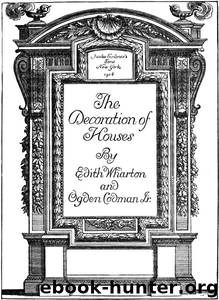The Decoration of Houses by Ogden Codman Jr. & Edith Wharton

Author:Ogden Codman Jr. & Edith Wharton [Ogden Codman Jr.]
Language: eng
Format: epub
Published: 2012-07-29T04:00:00+00:00
Parodi Palace Staircase STAIRCASE IN THE PARODI PALACE, GENOA.
XVI CENTURY.
(SHOWING INTER-MURAL STAIRS AND MARBLE FLOOR.)
PLATE XXX.
The spiral staircase, soon discarded by Italian architects save as a means of secret communication or for the use of servants, held its own in France throughout the Renaissance. Its structural difficulties afforded scope for the exercise of that marvellous, if sometimes superfluous, ingenuity which distinguished the Gothic builders. The spiral staircase in the court-yard at Blois is an example of this kind of skilful engineering and of the somewhat fatiguing use of ornament not infrequently accompanying it; while such anomalies as the elaborate out-of-door spiral staircase enclosed within the building at Chambord are still more in the nature of a tour de force,—something perfect in itself, but not essential to the organism of the whole.
Viollet-le-Duc, in his dictionary of architecture, under the heading Château, has given a sympathetic and ingenious explanation of the tenacity with which the French aristocracy clung to the obsolete complications of Gothic house-planning and structure long after frequent expeditions across the Alps had made them familiar with the simpler and more rational method of the Italian architects. It may be, as he suggests, that centuries of feudal life, with its surface of savagery and violence and its undercurrent treachery, had fostered in the nobles of northern Europe a desire for security and isolation that found expression in the intricate planning of their castles long after the advance of civilization had made these precautions unnecessary. It seems more probable, however, that the French architects of the Renaissance made the mistake of thinking that the essence of the classic styles lay in the choice and application of ornamental details. This exaggerated estimate of the importance of detail is very characteristic of an imperfect culture; and the French architects who in the fifteenth century were eagerly taking their first lessons from their contemporaries south of the Alps, had behind them nothing like the great synthetic tradition of the Italian masters. Certainly it was not until the Northern builders learned that the beauty of the old buildings was, above all, a matter of proportion, that their own style, freed from its earlier incoherencies, set out on the line of unbroken national development which it followed with such harmonious results until the end of the eighteenth century.
In Italy the staircase often gave directly upon the entranceway; in France it was always preceded by a vestibule, and the upper landing invariably led into an antechamber.
In England the relation between vestibule, hall and staircase was never so clearly established as on the Continent. The old English hall, so long the centre of feudal life, preserved its somewhat composite character after the grand'salle of France and Italy had been broken up into the vestibule, the guard-room and the saloon. In the grandest Tudor houses the entrance-door usually opened directly into this hall. To obtain in some measure the privacy which a vestibule would have given, the end of the hall nearest the entrance-door was often cut off by a screen that supported the musicians' gallery.
Download
This site does not store any files on its server. We only index and link to content provided by other sites. Please contact the content providers to delete copyright contents if any and email us, we'll remove relevant links or contents immediately.
Kathy Andrews Collection by Kathy Andrews(11730)
The remains of the day by Kazuo Ishiguro(8823)
Paper Towns by Green John(5091)
Spare by Prince Harry The Duke of Sussex(5072)
Industrial Automation from Scratch: A hands-on guide to using sensors, actuators, PLCs, HMIs, and SCADA to automate industrial processes by Olushola Akande(4983)
The Body: A Guide for Occupants by Bill Bryson(4974)
Machine Learning at Scale with H2O by Gregory Keys | David Whiting(4183)
Be in a Treehouse by Pete Nelson(3948)
Never by Ken Follett(3793)
Harry Potter and the Goblet Of Fire by J.K. Rowling(3775)
Goodbye Paradise(3728)
Into Thin Air by Jon Krakauer(3313)
The Remains of the Day by Kazuo Ishiguro(3294)
The Cellar by Natasha Preston(3262)
The Genius of Japanese Carpentry by Azby Brown(3226)
Fairy Tale by Stephen King(3220)
120 Days of Sodom by Marquis de Sade(3182)
The Man Who Died Twice by Richard Osman(2997)
Drawing Shortcuts: Developing Quick Drawing Skills Using Today's Technology by Leggitt Jim(2996)
